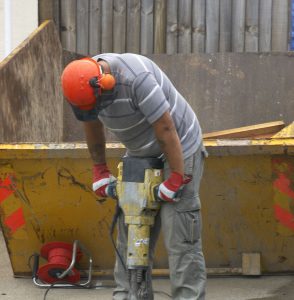Hindsight is always 20/20, but your foresight can be just as great when you understand how to spot a vision hazard on your worksite. Each year, eye injuries cost more than $300 million in lost production time, medical expenses and workers’ compensation. Ninety percent of the nearly 2,000 U.S. workplace eye injuries that occur on worksites each day are preventable. Personal protective equipment such as safety glasses, face masks, and goggles help to keep eyes free from chemicals and other hazards.
Below is a list of the top eye hazards in the workplace, what dangers they present, and what proper protective equipment should be used. This list can help keep your worksite safe and OSHA compliant.
Chemicals & Radiation
Chemical vision hazards may be endangering your workers. The job duties listed below are likely to cause chemical interactions with the eyes, if proper safety precautions are not taken:
- Handling Liquid Chemicals – Chemicals that are in liquid form are especially dangerous to the workers who handle them. Splashes can result in severe burning of the eye tissue.
- Welding – This can lead to intense UV radiation due to the arcs and flashes that are created in the process.
- Cementing – Wet or powdered cement in the eye can cause a chemical burn.
Protective equipment can be very effective for decreasing chemical hazards. Different jobs may require different gear based on the level of exposure. Goggles are the most common equipment used when there is a lower level of exposure. They form a protective seal around the eyes where the material is flush with the face. Goggles will provide basic protection, however, they do not protect the rest of the face from chemical splashes or sprays.
Face shields can provide the full-face protection that goggles cannot. They are secondary protectors that should be worn over glasses or goggles. A good face shield should protect the face from the top of the head down to the chin and wrap around to the ears. These masks can also protect the face from radiation, although when there is a larger amount of radiation a helmet should be used.
Finally, something that all worksites in which workers interact with chemicals must have is an emergency eyewash station. If employees are exposed to particles or non-corrosive liquids, then portable squeeze bottle eye washes are suitable protection and should be available to all workers. A larger eye wash station should be used on worksites with caustic chemicals. In the event of chemical contact with the eyes, an eye wash station is designed for 15 minutes of continuous operation.
Debris & Flying Objects
Debris is a common threat to eyes in general, but many worksite situations make the threat of eye interference more likely. According to a Bureau of Labor Statistics Survey, 70 percent of job site injuries are caused by flying debris or falling objects. Below are some of the most common perpetrators of these types of eye injuries:
- Windy Conditions – Wind can kick up particles, both dangerous and non-dangerous, that still may cause damage to the eye. Small particles can lead to scratches and scrapes of the eye. Falling objects are more likely to occur when there is wind, although they may result from negligence as well.
- Insulation Installation – Insulation contains substances such as mineral wool and fiberglass that are harmful to the eyes. This can lead to particle contact which causes irritation and scratching.
- Masonry Work – Hammering, grinding, and sanding all put particles in the air that can become an eye hazard. Masonry and job site materials in general — such as wood slivers, metal strips, and nails — can come into contact with the eye(s) and cause irreparable damage.
The risk of particles can be greatly reduced with something as simple as glasses with side protection. However, employers should make sure to use industrial eyewear that is specifically created for the job site. It is produced from stronger materials than regular glasses and goggles, and designed to protect eyes in accordance with OSHA standards.
More severe exposure to debris may constitute the use of a facemask. It is extremely important that employers evaluate the risk of vision hazards on the job site. OSHA requires that workers be provided suitable eye protection, but that can be a complicated task. Some workers may need to use a different type of protection from day to day, or even different hours, as their duties change.
Negligence
Employers are responsible for creating safe worksite environments. This makes negligence the No. 1 vision hazard to workers. Employers can stay on top of workplace safety by being aware of the formation of bad habits, such as poor maintenance and substandard safety reviews — as well as becoming educated on protective eye equipment.
An easy way for employers to make sure their worksites are safe is with Medical Surveillance Testing. Medical surveillance offers comprehensive screening of workers, which includes vision testing and other evaluations (i.e. respiratory fit testing, urinalysis, blood testing and more). Vision testing helps to ensure that workers do not have vision or eye damage. Employers will know if any further safety measures need to be taken, and thus they will be prepared when OSHA visits.
Learn more about mobile Medical Surveillance Testing HERE




